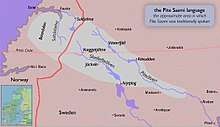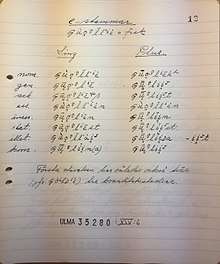Pite Sami language
| Pite Sami | |
|---|---|
| Bidumsámegiella | |
| Native to | Norway, Sweden |
Native speakers | 25 to 50 (2010)[1] |
| Latin | |
| Language codes | |
| ISO 639-3 |
sje |
| Glottolog |
pite1240[2] |
 Pite Sami is 3 on this map. | |

Pite Sami, also known as Arjeplog Sami, is a Sami language traditionally spoken in Sweden and Norway. It is a critically endangered language[3] that has only about 25–50[1] native speakers left and is now only spoken on the Swedish side of the border along the Pite River in the north of Arjeplog and Arvidsjaur and in the mountainous areas of the Arjeplog municipality.
Classification
Pite Sami is a part of the Western Sami group, together with Southern Sami and Ume Sami to the south, Lule Sami and Northern Sami to the north. Of these, Pite Sami shows closest affinity to Lule Sami, but a number of features also show similarity to Ume and Southern Sami.
Phonology
Consonants
The Pite Sami consonant inventory is very similar to that found in neighbouring Lule Sami, but lacks contrastive voicing of stops and affricates entirely.
| Labial | Dental | Alveolar | Postalveolar | Palatal | Velar | ||
|---|---|---|---|---|---|---|---|
| Nasal | m | n | ɲ | ŋ | |||
| Plosive / Affricate | p | t | t͡s | t͡ʃ | k | ||
| Fricative | voiceless | f | s | ʃ | h | ||
| voiced | v | (ð) | |||||
| Semivowel | j | ||||||
| Lateral | l | ||||||
| Trill | r | ||||||
- Stops before a homorganic nasal (pre-stopped nasals) are realised as unreleased stops.
- /v/ is realised as a labiodental fricative [v] in the syllable onset (before a vowel), and as bilabial [w] in the syllable coda (in a consonant cluster).
- /ð/ is present only in the language of some elderly speakers. It is otherwise replaced by /r/ or /t/, depending on dialect.
Vowels
The Pite Sami vowel inventory has a relative lack of phonemic diphthongs, compared to other Sami languages and particularly neighbouring Lule Sami. Instead, there are more vowel height distinctions.
| Monophthongs | Diphthongs | |||
|---|---|---|---|---|
| Front | Back | Front | Back | |
| Close | i | u | (ie̯) | (uo̯) |
| Close-mid | e | o | uæ̯ | uɑ̯ |
| Open-mid | ɛ | ɔ ɔː | ||
| Open | a aː | |||
- The close vowels /i/ and /u/ are realized as laxer [ɪ] and [ʊ] respectively, in unstressed positions.
- Close-mid /e/ and /o/ are diphthongized to [ie̯] and [uo̯] respectively, when stressed.
- /ɔ/ contrasts with /ɔː/ in near-minimal pairs such as båhtet /ˈpɔːhtet/ "to come" vs båhtjet /ˈpɔhtet/ "to milk".
- /ɛ/ does not occur in unstressed syllables.
- /ɔ/ can occur in unstressed syllables, but only when a preceding stressed syllable contains /ɔ/.
Dialects
Sammallahti[5] divides Lule Sami dialects as follows:
- Northern dialects: Luokta-Mávas in Sweden
- Central dialects: Semisjaur-Njarg in Sweden
- Southern dialects: Svaipa in Sweden
Features of the northern dialects are:
- Lack of /aː/ → /eː/ umlaut.
- Voicing in quantity 3 of plain stops (thus strong /bː.b/ ~ weak /p.p/ etc.), like in Lule Sami.
- /t/ as the outcome of Proto-Samic *đ.
Features of the southern dialects are:
- /r/ as the outcome of Proto-Samic *đ.
Orthography
Pite Sámi is one of the four Sami languages that does not have an official written language. A working orthography has been developed in 2008–2011 by the Sami Association of Arjeplog.[6] It closely resembles the orthography of neighbouring Lule Sami.
| Letter | Phoneme(s) | Notes |
|---|---|---|
| A a | /a/ | |
| Á á | /aː/ | |
| B b | /p/ | |
| D d | /t/ | |
| Đ đ | /ð/ | |
| E e | /eː/ | Only unstressed. |
| F f | /f/ | |
| G g | /k/ | |
| H h | /h/ | |
| I i | /i/ | |
| J j | /j/ | |
| K k | /k/, /kʰ/ | Postaspirated at the beginning of a stressed syllable. |
| L l | /l/ | |
| M m | /m/ | |
| N n | /n/ | |
| Ŋ ŋ | /ŋ/ | |
| O o | /oː/ | Only unstressed. |
| P p | /p/, /pʰ/ | Postaspirated at the beginning of a stressed syllable. |
| R r | /r/ | |
| S s | /s/ | |
| T t | /t/, /tʰ/ | Postaspirated at the beginning of a stressed syllable. |
| U u | /u/ | |
| V v | /v/ | |
| Å å | /ɔ/, /ɔː/ | |
| Ä ä | /ɛː/ |
Grammar
Cases
Pite Sámi has 9 cases:

Verbs
Person
Pite Sami verbs conjugate for three grammatical persons:
- first person
- second person
- third person
Mood
Pite Sami has five grammatical moods:
Grammatical number
Pite Sami verbs conjugate for three grammatical numbers:
Tense
Pite Sami verbs conjugate for two simple tenses:
and two compound tenses:
Negative verb
Pite Sami, like Finnish, the other Sámi languages and Estonian, has a negative verb. In Pite Sámi, the negative verb conjugates according to mood (indicative, imperative and optative), person (1st, 2nd and 3rd) and number (singular, dual and plural). This differs from some other the other Sami languages, e.g. from Northern Sami, which do not conjugate according to tense and other Sami languages, that do not use the optative.
Non-past indicative Past indicative
sg. du. pl. sg. du. pl.
1 iv ien iehp 1 ittjiv iejmen iejmeh
iep ittjijmen ittjijmeh
2 ih iehpen iehpit 2 ittjih iejten iejteh
ähpen ihpit ittjijten ittjijteh
ihpen
3 ij iepá ieh 3 ittjij iejkán ittjin
iepán ittjijka
For non-past indicative versions that have more than one form, the second one is from the dialect spoken around Björkfjället and the third is from the Svaipa dialect. The plurality in the other forms is due to parallel forms that are not bound by dialect.
Imperative Optative
sg. du. pl. sg. du. pl.
1 - - - 1 alluv iellun iellup
allun allup
2 ieleh iellen iellit 2 alluh ielluten ielluteh
alluten alluteh
3 - - - 3 allus ielluska ielluseh
alluska alluseh
Notes
- 1 2 At least 25 speakers in 2010 according to researcher Joshua Wilbur. At least 30 active, native speakers in 2010; at least an additional 20 native speakers who do not use the language actively according to the Pite Sami dictionary project leader Nils Henrik Bengtsson.
- ↑ Hammarström, Harald; Forkel, Robert; Haspelmath, Martin, eds. (2017). "Pite Sami". Glottolog 3.0. Jena, Germany: Max Planck Institute for the Science of Human History.
- ↑ UNESCO Interactive Atlas of the World’s Languages in Danger
- ↑ (Wilbur 2014: 63–70)
- ↑ Sammallahti, Pekka (1998). The Saami Languages: An Introduction. Kárášjohka: Davvi Girji.
- ↑ (Wilbur 2014:18–19)
References
- Lagercrantz, Eliel (1926). Sprachlehre des Westlappischen nach der Mundart von Arjeplog. Suomalais-Ugrilaisen Seuran Toimituksia. 25. Helsinki: Suomalais-Ugrilainen Seura.
- Lehtiranta, Juhani (1992). Arjeploginsaamen äänne- ja taivutusopin pääpiirteet. Suomalais-Ugrilaisen Seuran Toimituksia. 212. Helsinki: Suomalais-Ugrilainen Seura. ISBN 951-9403-55-8.
- Pite Saami Documentation Project. www2.hu-berlin.de/psdp. 2009.05.03.
- Wilbur, Joshua (2014). A Grammar of Pite Sami. Studies in Diversity Linguistics. 5. Berlin: Language Science Press. ISBN 978-3-944675-47-3. Retrieved 2014-10-10.